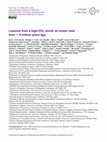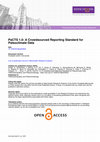Papers by Montserrat Alonso-Garcia

Climate of The Past, Aug 27, 2020
A range of future climate scenarios are projected for high atmospheric CO 2 concentrations, given... more A range of future climate scenarios are projected for high atmospheric CO 2 concentrations, given uncertainties over future human actions as well as potential environmental and climatic feedbacks. The geological record offers an opportunity to understand climate system response to a range of forcings and feedbacks which operate over multiple temporal and spatial scales. Here, we examine a single interglacial during the late Pliocene (KM5c, ca. 3.205 ± 0.01 Ma) when atmospheric CO 2 exceeded pre-industrial concentrations, but were similar to today and to the lowest emission scenarios for this century. As orbital forcing and continental configurations were almost identical to today, we are able to focus on equilibrium climate system response to modern and near-future CO 2. Using proxy data from 32 sites, we demonstrate that global mean sea-surface temperatures were warmer than pre-industrial values, by ∼ 2.3 • C for the combined proxy data (foraminifera Mg/Ca and alkenones), or by ∼ 3.2-3.4 • C (alkenones only). Compared to the preindustrial period, reduced meridional gradients and enhanced warming in the North Atlantic are consistently reconstructed. There is broad agreement between data and models at the global scale, with regional differences reflecting ocean circulation and/or proxy signals. An uneven distribution of proxy data in time and space does, however, add uncertainty to our anomaly calculations. The reconstructed global mean seasurface temperature anomaly for KM5c is warmer than all but three of the PlioMIP2 model outputs, and the reconstructed North Atlantic data tend to align with the warmest KM5c model values. Our results demonstrate that even under low-CO 2 emission scenarios, surface ocean warming may be expected to exceed model projections and will be accentuated in the higher latitudes.
Climate of The Past, Apr 7, 2017
Arctic freshwater discharges to the Labrador Sea from melting glaciers and sea ice can have a lar... more Arctic freshwater discharges to the Labrador Sea from melting glaciers and sea ice can have a large impact on ocean circulation dynamics in the North Atlantic, modifying climate and deep water formation in this region. In this study, we present for the first time a high resolution record of ice rafting in the Labrador Sea over the last millennium to assess the effects of freshwater discharges in this region on ocean circulation and climate. The occurrence of ice-rafted debris (IRD) in the Labrador Sea was studied using sediments from Site GS06-144-03 (57.29 • N, 48.37 • W; 3432 m water depth). IRD from the fraction 63-150 µm shows particularly high concentrations during the intervals ∼

<p>Sensitive areas, like those of the upwelling systems, which are responsible for ... more <p>Sensitive areas, like those of the upwelling systems, which are responsible for high ecological diversity, fisheries resources and air-sea CO<sub>2</sub> exchanges are threatened by climate warming, and therefore, it is crucial to understand how they behaved in past warm climates. The Iberian margin upwelling system corresponds to the northern branch of the Canary Eastern Boundary Upwelling System. At the present, seasonal upwelling of cold and nutrient-rich waters makes the margin highly productive, being responsible for the high ecological biodiversity richness in the area. Despite of its enormous ecological and social importance, the knowledge on how the upwelling system worked in the past is still limited, particularly for periods older than 900 ka. </p><p>In this work, we focused on the reconstruction of surface water conditions during the Late Pliocene, a period characterized by warm temperatures and high atmospheric CO<sub>2</sub> concentration and considered as a unique analogue for future climate conditions. We studied sediments from IODP Site U1391 (37°21.5′N; 9°24.6′W, 1085 m water depth), recovered at the Southwest Iberian margin during Expedition 339, which provided for the first time, an almost continuous marine record of the SW Iberian margin dating back to the Pliocene. Surface water conditions have been reconstructed using planktonic foraminifer faunas and lipid biomarker concentrations across Marine Isotope Stages (MIS) G12 to G3 (2.84 to 2.66 Ma). The planktonic foraminifer results are being compared to the alkenone derived sea-surface temperature (SST), and the total alkenone concentration (reflecting coccolithophore productivity) records of Site U1391 in order to get a comprehensive interpretation of changes in sea surface productivity, seasonality and ecological diversity.</p><p> </p>
Reviews of Geophysics, Jun 14, 2023
HAL is a multidisciplinary open access archive for the deposit and dissemination of scientific re... more HAL is a multidisciplinary open access archive for the deposit and dissemination of scientific research documents, whether they are published or not. The documents may come from teaching and research institutions in France or abroad, or from public or private research centers. L'archive ouverte pluridisciplinaire HAL, est destinée au dépôt et à la diffusion de documents scientifiques de niveau recherche, publiés ou non, émanant des établissements d'enseignement et de recherche français ou étrangers, des laboratoires publics ou privés.

Research Square (Research Square), May 15, 2023
Evolutionary or adaptative changes in Noelaerhabdaceae coccolithophores occurred in parallel with... more Evolutionary or adaptative changes in Noelaerhabdaceae coccolithophores occurred in parallel with major changes in carbonate export and burial during scenarios of low orbital eccentricity, with a ~ 400 kyr recurrence, during the Pleistocene. Coeval with these conditions of enhanced proliferation, here we report a globally enhanced calci cation intensity of specimens across multiple species or morphotypes within the Gephyrocapsa complex during the Mid-Brunhes (MB) interval, 400 ka. Seawater alkalinity is proposed as the environmental trigger for the increased production of both the inorganic and organic carbon, possibly implemented by a coupled increase in nutrient delivery. The strong biological pump triggered by the enhanced proliferation of highly calci ed Gephyrocapsa, together with respiration dissolution, would have contributed to the associated deep sea dissolution event at the ~ 400 kyr scale, limiting the removal of alkalinity by burial, and maintaining constant levels at this scale. This new perspective highlights, rst, the role of orbital forcing in phytoplankton evolution or adaptation through changes in the seawater carbon chemistry. Second, the capacity of the Noelaerhabdaceae acmes to modify the typical behavior of carbonate compensation in the ocean. Our ndings suggests that changes in coccolith calci cation intensity may indicate changes in past ocean carbonate chemistry and the operation of the global carbon cycle under contrasting background conditions during the Cenozoic.
Proceedings of the International Ocean Discovery Program, May 4, 2017
This work is distributed under the Creative Commons Attribution 4.0 International (CC BY 4.0) lic... more This work is distributed under the Creative Commons Attribution 4.0 International (CC BY 4.0) license. Contents 1 Background and objectives 2 Operations 5 Lithostratigraphy 14 Biostratigraphy 19 Geochemistry 23 Paleomagnetism 26 Physical properties 31 Downhole measurements 36 Seismic stratigraphy 39 References
Proceedings of the International Ocean Discovery Program, May 4, 2017
This work is distributed under the Creative Commons Attribution 4.0 International (CC BY 4.0) lic... more This work is distributed under the Creative Commons Attribution 4.0 International (CC BY 4.0) license. Contents 1 Background and objectives 1 Operations 7 Lithostratigraphy 12 Biostratigraphy 21 Geochemistry 25 Paleomagnetism 30 Physical properties 36 Downhole measurements 47 Stratigraphic correlation and sedimentation rates 49 Seismic stratigraphy 51 References

Marine Geology, Jul 1, 2018
Based on high-resolution reflection seismic and core data from IODP Expedition 359 we present a n... more Based on high-resolution reflection seismic and core data from IODP Expedition 359 we present a new channel-related drift type attached to a carbonate platform slope, which we termed delta drift. Like a river delta, it is comprised of several stacked lobes and connected to 3 3 a point source. The delta drifts were deposited at the exit of two gateways that connect the Inner Sea of the Maldives carbonate platform with the open ocean. The channels served as conduits focusing and accelerating the water flow; Entrained material was deposited at their mouth where the flows relaxed. The lobe-shaped calcareous sediment drifts must have formed under persistent water through flow. Sediment supply was relatively high and continuous, resulting in an average sedimentation rate of 17 cm ka-1. The two delta drifts occupy 342 and 384 km 2 , respectively; with a depositional relief of approximately 500 m. They have a sigmoidal clinoform reflection pattern with a particular convex upward bending of the foresets. In the Maldives the drift onset marks the transition from a sea-level controlled to a progressively current dominated depositional regime. This major event occurred in the Serravallian about 13 Ma ago, leading to the partial drowning of the carbonate platform and the creation of shallow seaways. The initial bank-enclosed topography resembles an "empty bucket" geometry which is rapidly filled by the drift sediments that aggrade and prograde into the basin. Thereby the depositional environment of the delta drifts changes from deep water (>500) to shallow-water conditions at their topsets, indicated by the overall coarsening upward trend in grain size and the presence of shallow water large benthic foraminifers at their top.
AGU Fall Meeting Abstracts, Dec 1, 2018
EGU General Assembly Conference Abstracts, Apr 1, 2019
Reconstrucción de la posición del frente ártico a partir de las asociaciones de foraminíferos pla... more Reconstrucción de la posición del frente ártico a partir de las asociaciones de foraminíferos planctónicos durante los estadios isotópicos marinos 14, 15 y 16 Arctic front reconstruction based on planktic foraminifer assemblages analyses for the marine isotope stages 14, 15 and 16
Marine Micropaleontology, Jun 1, 2022
Cuaternario y geomorfología, Dec 15, 2022
Derechos de reproducción bajo licencia Creative Commons 3.0. Se permite su inclusión en repositor... more Derechos de reproducción bajo licencia Creative Commons 3.0. Se permite su inclusión en repositorios sin ánimo de lucro.

At ODP Site 1090, following initial publication of the SST data (Martinez-Garcia et al., 2010) an... more At ODP Site 1090, following initial publication of the SST data (Martinez-Garcia et al., 2010) an alternative orbitally-tuned age model was generated using n-alkane concentrations as a proxy for dust inputs, and an anticipated continuation of the Pleistocene relationship of high dust with high 18 O i.e. during glacial stages (Martinez-Garcia et al., 2011). This n-alkane age model aligns KM5c with high nalkane concentrations and low SSTs, whereas the reverse pattern might be expected (Figure S1). If the cold interval is realigned to KM4, SSTs during KM5c at ODP 1090 are elevated by 0.5°C (Figure S1). Given current stratigraphic information for ODP 1090 it is not possible to determine which of these scenarios is correct; thus, we present the SST anomalies according to the original age model, noting that there could be an additional increase in those anomalies of up to 0.5°C depending upon the choice of sample ages. At ODP Site 806, uncertainty over age control resulted from the absence of an agreed splice across the multiple holes drilled by ODP. High-resolution benthic foraminifera 18 O records were generated on Hole 806B (Bickert et al., 1993;Karas et al., 2009). Here we update the age model using the HMM-Stack Matlab code (Lin et al., 2014), which aligns to the Prob-stack (Ahn et al., 2017). Additionally, we created a modified meters composite depth (mcd). Using the depth scale generated by Karas et al., (2009) to account for core expansion, we amend Holes 806A and 806C to this depth scale (Matlab code will be provided). The KM5c interval is muted in Prob-stack in comparison to LR04 (Ahn et al., 2017). Given the variability in the Site 806 benthic 18 O record (Figure 1), it is difficult to identify the KM5c interval and we rely on the probabilistic alignment of HMM-Match. If we tied the record to LR04 between M2 and KM2 and assumed a linear sedimentation rate, however, the age model in practice would be similar.

Paleoceanography and Paleoclimatology, 2019
The progress of science is tied to the standardization of measurements, instruments, and data. Th... more The progress of science is tied to the standardization of measurements, instruments, and data. This is especially true in the Big Data age, where analyzing large data volumes critically hinges on the data being standardized. Accordingly, the lack of community‐sanctioned data standards in paleoclimatology has largely precluded the benefits of Big Data advances in the field. Building upon recent efforts to standardize the format and terminology of paleoclimate data, this article describes the Paleoclimate Community reporTing Standard (PaCTS), a crowdsourced reporting standard for such data. PaCTS captures which information should be included when reporting paleoclimate data, with the goal of maximizing the reuse value of paleoclimate data sets, particularly for synthesis work and comparison to climate model simulations. Initiated by the LinkedEarth project, the process to elicit a reporting standard involved an international workshop in 2016, various forms of digital community engagem...
Palaeogeography, Palaeoclimatology, Palaeoecology, 2019
General rights Copyright and moral rights for the publications made accessible in the public port... more General rights Copyright and moral rights for the publications made accessible in the public portal are retained by the authors and/or other copyright owners and it is a condition of accessing publications that users recognise and abide by the legal requirements associated with these rights. • Users may download and print one copy of any publication from the public portal for the purpose of private study or research. • You may not further distribute the material or use it for any profit-making activity or commercial gain • You may freely distribute the URL identifying the publication in the public portal ? Take down policy If you believe that this document breaches copyright please contact us providing details, and we will remove access to the work immediately and investigate your claim.










Uploads
Papers by Montserrat Alonso-Garcia